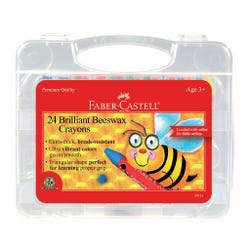An Evening with Frank Lloyd Wright

Description
Lesson Plan and Artwork by Nadine Dresbach
The purpose of this lesson is to help students analyze and study the use of lights and darks in an architectural setting and conceptually reverse them, transferring them to black paper, transforming to a nighttime image. With only a few materials a striking result can be created.
Objectives
- Study the work and history of architect Frank Lloyd Wright.
- Analyze color, highlight and shadow.
- Use perspective to render a Frank Lloyd Wright design.
Supplies Needed
Faber-Castell® Connector Paint Box, Assorted Colors, Set of 2
Faber-Castell® Jumbo Triangular Beeswax Crayons, Assorted Colors, Pack of 24
Crescent® No. 8 Ultra-Black Mounting Board, 9"x12", Pack of 40
*Here are the supplies needed for this lesson plan for reference. Find a convenient carousel of shoppable products for this lesson below.
Standards
Creating
Anchor Standard #2: Organize and develop artistic ideas in work.
Anchor Standard #3: Refine and complete artistic work.
Presenting
Anchor standard #5: Develop and refine artistic work for presentation.
Instructions
1
Students will begin by researching the works of Frank Lloyd Wright.
2
Select a design image that can be illustrated into an evening setting. Sketch a rough draft onto regular drawing paper the same size as the Crescent Ultra-Black Board. Think about what light sources would be coming from the interior and exterior of the structure.
3
Before proceeding to the Crescent Ultra-Black board, have students experiment on a scrap board or black piece of paper using the beeswax crayons and the Faber-Castell Connector Paint set using a variety of brushes. Note that several coats of the paint may be applied to intensify or vary the color. Make a swatch sample board on black of all of your color choices. This is very helpful in determining which colors will work best in which areas.
4
Moving onto the Crescent Ultra-Black board, use the beeswax crayons to lightly sketch your architectural design of choice onto the board.
5
The Faber-Castell Connector Paints and the beeswax crayons can and should be used simultaneously. Layering is greatly encouraged to achieve the desired results. Students will also find the black beeswax crayon to be a very useful tool as it can be used as an "eraser" or to tighten up edges.



